New reports published – June 2022
Published: 20 Jun 2022
Fifteen new resources have been published on our website this month. These include:
- CVDPREVENT Second Annual Report
- National Cardiac Audit Programme 2022 report
- National Adult Cardiac Surgery Audit: 2022 Summary report
- National Audit of Percutaneous Coronary Intervention: 2022 Summary report
- National Audit of Cardiac Rhythm Management: 2022 Summary report
- National Congenital Heart Disease Audit: 2022 Summary report
- National Heart Failure Audit: 2022 Summary report
- Management of Heart Attack: 2022 Summary report
- National Diabetes Audit, 2017-21: Adolescent and young adult type 1
- Adult Asthma and COPD 2021 Organisational Audit: Summary report
- Children and Young Person Asthma 2021 Organisational Audit: Summary report
- Sentinel Stroke National Audit Programme: Acute Organisational Audit 2021
- Sentinel Stroke National Audit Programme, Mimic Audit 2021: Short report
- National Maternity and Perinatal Audit: Clinical report 2022
- National Diabetes Audit, 2020-21: Type 1 Diabetes
CVDPREVENT Second Annual Report
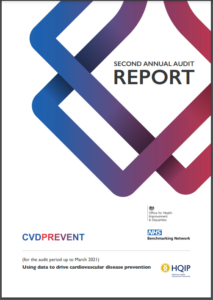 Based on GP record data up to March 2021, the audit saw an increase in coverage of GP practices to 93% (from 79%, when compared with the pre-pandemic baseline). Key findings include:
Based on GP record data up to March 2021, the audit saw an increase in coverage of GP practices to 93% (from 79%, when compared with the pre-pandemic baseline). Key findings include:
- Blood pressure (BP) monitoring has been affected by the pandemic, however, there was only small variation within the inequality breakdowns for BP monitoring compared with the pre-pandemic baseline (suggesting that no particular group missed out on recorded BP monitoring more than any other group).
- There has been little disruption to the prescription indicators. Anticoagulation for people with high-risk atrial fibrillation (AF) and lipid lowering therapy levels for people with existing CVD and chronic kidney disease (CKD) remain broadly similar in this latest round of data, compared the pre-pandemic baseline.
National Cardiac Audit Programme: The heart in lockdown report
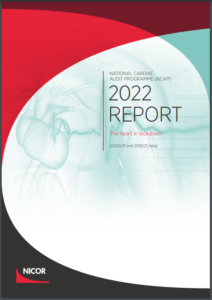 Based on data collected between 1 April 2020 and 31 March 2021, the report focuses on how cardiovascular services were impacted by the first year of the COVID-19 pandemic. Key findings include:
Based on data collected between 1 April 2020 and 31 March 2021, the report focuses on how cardiovascular services were impacted by the first year of the COVID-19 pandemic. Key findings include:
- Acute admissions were down during 2020/21, with a 9% reduction in those with STEMI, 18% fall in those with NSTEMI and a 12% fall in admissions for heart failure.
- Antenatal detection of congenital heart defects requiring intervention in the first year improved to 52%.
- There was increased referral of heart attack patients to cardiac rehabilitation – exceeded the 85% target at the end of 2020/21.
- More STEMI patients were investigated by echocardiography – now 77%.
National Adult Cardiac Surgery Audit: 2022 summary report
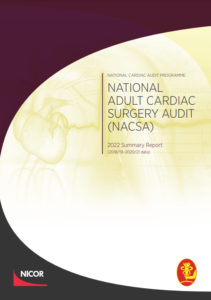 Based on data from England, Wales and Northern Ireland between 2018/19 and 2020/21, the report largely focuses on the changes within adult cardiac surgery that were seen during the COVID-19 pandemic. Key findings include:
Based on data from England, Wales and Northern Ireland between 2018/19 and 2020/21, the report largely focuses on the changes within adult cardiac surgery that were seen during the COVID-19 pandemic. Key findings include:
- The average waiting time for urgent CABG across the UK decreased slightly from 11 to 10 days (though only three hospitals met the seven-day target).
- There was a 21% increase in waiting times for CABG in England (to 125 days), 61% increase in Northern Ireland (to 197 days), and 94% increase in Wales (to 252 days). Only five NHS hospital met the 84-day target.
- Complications following coronary artery bypass grafting (CABG) surgery remain low, with stroke rates falling to 0.6% and reoperation for bleeding rates remaining low at 1.78%.
National Audit of Percutaneous Coronary Intervention: 2022 summary report
 Based on data collected between April 2020 to March 2021, the report focuses on a number of specific quality improvement (QI) metrics in relation to the delivery of PCI services derived from national and/or international standards and guidelines. Key findings include:
Based on data collected between April 2020 to March 2021, the report focuses on a number of specific quality improvement (QI) metrics in relation to the delivery of PCI services derived from national and/or international standards and guidelines. Key findings include:
- An increase in the proportion of day cases, with 69% of elective PCI procedures performed as a day case, up from 64% in 2018/19 (though there was wide variation in practice, determined by local logistic issues and not patient characteristics),
- The use of primary PCI was up 2% in 2020/21 compared with the previous year (partly driven by the procedure being an alternative to surgery in appropriate cases), but
- Intravascular imaging was used in 67% of cases involving left main stem PCI, rising from 57% the previous year (but with wide variability between hospitals)
- There was a significant fall in PCI procedures, down 10% from just over 100,000 in 2019/20 to 90,708 in 2020/21.
National Audit of Cardiac Rhythm Management: 2022 summary report
 Based on data collected between April 2020 to March 2021, the report focuses on a number of specific quality improvement (QI) metrics in relation to the delivery of PCI services derived from national and/or international standards and guidelines. Key findings include:
Based on data collected between April 2020 to March 2021, the report focuses on a number of specific quality improvement (QI) metrics in relation to the delivery of PCI services derived from national and/or international standards and guidelines. Key findings include:
- 84% of hospitals met the national standards for ablation volumes (89% in 2019/20) and 87% met standards for AF ablation (previously 89%)
- Hospitals planned their services to avoid patients missing device changes for battery depletion.
- Levels of 1-year follow-up of patients implanted with devices remained at previous levels, indicating those suffering complications continued to be identified and treated appropriately.
- There was a 50% fall in procedures during the first wave of COVID-19 hospitalisations, with a smaller but significant fall in the second wave.
National Congenital Heart Disease Audit: 2022 summary report
 Based on data collected between April 2020 to March 2021, the report aims to improve the quality of care received by patients from UK or Ireland hospital admission to discharge, and ensure they meet good practice standards. Key findings include:
Based on data collected between April 2020 to March 2021, the report aims to improve the quality of care received by patients from UK or Ireland hospital admission to discharge, and ensure they meet good practice standards. Key findings include:
- Antenatal diagnosis for all infants requiring a procedure in the first year of life rose to 52% (though variations between centres show scope for improvement), and fetal anomaly screening continued nationally despite the pandemic.
- Outcomes after paediatric cardiac surgery continue to show a high 30-day survival rate of over 98%.
- The 30-day survival rate in adults was very good, with approximately 10% fewer deaths than predicted across 2,302 congenital heart disease (CHD) operations.
- Patients with increasing severity of complex CHD (e.g. Fontan circulation) are linked to a higher risk of COVID-19 related complications and associated mortality.
National Heart Failure Audit: 2022 summary report
 Based on data collected between April 2020 and March 2021 from across England and Wales, the report summarises the key findings from the audit and deals with a specific and crucial phase in the disease trajectory of patients admitted to hospital with heart failure.Key findings include:
Based on data collected between April 2020 and March 2021 from across England and Wales, the report summarises the key findings from the audit and deals with a specific and crucial phase in the disease trajectory of patients admitted to hospital with heart failure.Key findings include:
- 65% of hospitals achieved specialist review rates of over 80%, an increase of 4%.
- A 10% improvement in the number of hospitals achieving the 90% or greater prescription of beta-blockers for HFrEF patients.
- In-patient mortality of 9.2% and 1-year mortality of 39% were the same as for 2019/20 (30-day mortality rose slightly).
- Median length of stay (LOS) fell from 9 days to 8 days in cardiology and for those seen by specialists (but a shorter LOS may compromise patient stability pre-discharge).
Management of Heart Attack: 2022 summary report
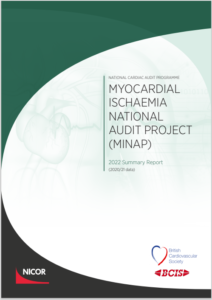 This report into the management of heart attack is based on data from the Myocardial Ischaemia National Audit Project (MINAP) and the National Audit of Percutaneous Coronary Intervention (NAPCI). Key findings include:
This report into the management of heart attack is based on data from the Myocardial Ischaemia National Audit Project (MINAP) and the National Audit of Percutaneous Coronary Intervention (NAPCI). Key findings include:
- There was a substantial increase in timely angiography for lower risk NSTEMI cases, with 66% of patients receiving an angiogram within the 72-hour quality standard. Though there was large monthly variation associated with pandemic waves and associated ‘lockdowns’, and performance deteriorated with re-start of elective PCI.
- The highest recorded levels of reperfusion were sustained for higher risk STEMI patients, with 83% of patients receiving reperfusion treatment (maintained from the previous year).
- There was a continued increase in pre-discharge echocardiography, with 77% of patients undergoing echocardiography prior to discharge.
National Diabetes Audit, 2017-21: Adolescent and young adult type 1
Based on date from people with type 1 diabetes aged 15-25 years old in England (with limited data from Wales) between 1 January 2017 and 31 March 2021, report found that there were more males than females (55.2% vs 44.8%) with type 1 diabetes, and more than expected lived in areas of social deprivation. Other key findings include:
- The proportion of people who were living with overweight and obesity increased progressively from the age of 18 years old.
- Diabetic ketoacidosis (DKA) frequency (single and multiple inpatient admissions with episode of DKA) started to rise at 16 years old, peaked at 18 years old and then fell slowly but progressively.
- 81.9% of adolescents using insulin pumps continue to do so in young adulthood; however,
- Insulin pump usage rates dropped by almost two thirds (33.3% to 12.1%) between the ages of 15 and 25 years.
National Diabetes Audit, 2020-21: Type 1 Diabetes
Based on data collected between 1 January 2020 and 31 march 2021 in England and Wales, the report details the findings and recommendations relating to diabetes care process completion, treatment target achievement and structured education for people with type 1 diabetes aged 19 year and over. Key findings include:
- Due to the COVID-19 pandemic restrictions, care process completion reduced markedly in 2020-21 – for example glycated haemoglobin (HbA1c) checks reduced from 88% to 80% and Body Mass Index (BMI) measurements from 86% to 67%.
- However, by contrast, overall HbA1c treatment target achievement improved in 2020-21; for example, the median rate of achieving HbA1c ≤58mmol/mol (7.5%) increased from 28% in 2019-20 to 31% in 2020-21.
- The use of non-invasive glucose monitoring and insulin pump technology was associated with lower HbA1c. These technologies were being used more by adults of white ethnicity and adults in areas of low deprivation than by adults of other ethnicities and in more deprived areas. Findings were similar for recorded completion of structured education.
- All care processes and treatment outcomes vary by location – e.g. both CCG/LHB data and partial specialist service data show ranges of 20-45% in achievement of HbA1c ≤58mmol/mol (7.5%) by location
Adult Asthma and COPD 2021 Organisational Audit: Summary report
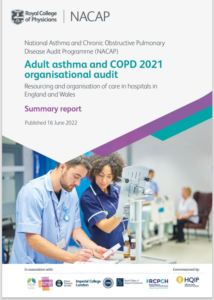 Based on data collected between 6 September to 8 October 2021, the report presents information on the structure and resourcing of 159 out of 198 of the hospital services that provide asthma and COPD care to adults in England and Wales. Findings (compared to NACAP’s first organisational audit in 2019) include:
Based on data collected between 6 September to 8 October 2021, the report presents information on the structure and resourcing of 159 out of 198 of the hospital services that provide asthma and COPD care to adults in England and Wales. Findings (compared to NACAP’s first organisational audit in 2019) include:
- A higher percentage of services have a designated clinical lead in place for asthma and COPD,
- The provision of specialist respiratory review seven days a week continues to vary,
- A higher percentage of services have at least one formal transition arrangement in place for young people with asthma (41.1% compared to 30%), and
- Less than half of services (42.1%) offer access to pulmonary rehabilitation (PR) services within 30 days of discharge for patients with COPD, compared to 45% in 2019.
Children and Young Person Asthma 2021 Organisational Audit: Summary report
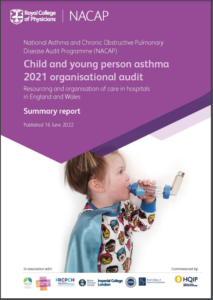 Based on data collected between 4 October and 5 November 2021, the report presents information on the structure and resourcing of 136 out of 143 (95%) hospital-based services that provide acute asthma care to children and young people (CYP) in England and Wales. Findings (compared to NACAP’s first CYP organisational audit on data from June 2019 to January 2020) include:
Based on data collected between 4 October and 5 November 2021, the report presents information on the structure and resourcing of 136 out of 143 (95%) hospital-based services that provide acute asthma care to children and young people (CYP) in England and Wales. Findings (compared to NACAP’s first CYP organisational audit on data from June 2019 to January 2020) include:
- The proportion of hospitals participating in the audit increased to 95%,
- There has been a significant improvement in the provision of spirometry and fractional exhaled nitric oxide (FeNO) diagnostic tools to diagnose asthma, and
- While, there may have been an improvement in hospitals offering some aspects of transition for CYP with asthma, the overall quality of transition is still suboptimal.
Sentinel Stroke National Audit Programme: Acute Organisational Audit 2021
 Based on data from 182 acute stroke services across England, Wales, Northern Ireland and the Isle of Man, this report provides an overview of the organisation of acute stroke services on the census date of 1 October 2021, with comparative information on the provision of services in six domains (Workforce, Seven-day Working, Access to Specialist Treatment, Patient and Carer Engagement, TIA Services and Quality Improvement/Leadership). Key findings include:
Based on data from 182 acute stroke services across England, Wales, Northern Ireland and the Isle of Man, this report provides an overview of the organisation of acute stroke services on the census date of 1 October 2021, with comparative information on the provision of services in six domains (Workforce, Seven-day Working, Access to Specialist Treatment, Patient and Carer Engagement, TIA Services and Quality Improvement/Leadership). Key findings include:
- 42% of services now offer at least two types of rehabilitation therapy 7 days per week.
- The use of MRI as first-line imaging for TIA patients increased substantially to 49%, in line with 2019 NICE Clinical Guideline NG128.
- Up to 76% of services offer access to stroke specialist early supported discharge teams.
- Nurse staffing on stroke units has deteriorated, with significantly fewer sites meeting recommendations for senior nursing supervision of acute stroke beds (down 12% to 46%).
Sentinel Stroke National Audit Programme, Mimic Audit 2021: Short report
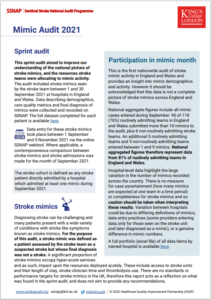 Based on data from hospitals in England and Wales between 1 and 30 September 2021, the report into stroke mimics aims to improve understanding of the national picture of stroke mimics, and the resources that stroke teams were allocating to mimic activity. Key findings include:
Based on data from hospitals in England and Wales between 1 and 30 September 2021, the report into stroke mimics aims to improve understanding of the national picture of stroke mimics, and the resources that stroke teams were allocating to mimic activity. Key findings include:
- 52.8% of stroke assessments were finally diagnosed as stroke mimics (6,351 mimics reported in comparison to 5,672 strokes).
- There are a wide range of medical and neurological conditions presenting as stroke mimics, with neurological mimics making up the biggest group.
- The majority of patients were assessed by a stroke clinician in person (93%).
- Stroke mimics were rapidly discharged from the stroke unit with a median length of stay of 1.7 days. However, 6.3% of mimics had a length of stay of 10 days or more.
National Maternity and Perinatal Audit: Clinical report 2022
 Based on births in NHS maternity services between 1 April 2018 and 31 March 2019 in England and Wales, the report captures 89% of eligible births, finding that one third of women and birthing people with singleton pregnancies at term underwent an induction of labour. Other key findings include:
Based on births in NHS maternity services between 1 April 2018 and 31 March 2019 in England and Wales, the report captures 89% of eligible births, finding that one third of women and birthing people with singleton pregnancies at term underwent an induction of labour. Other key findings include:
- Of those experiencing their first birth, 23% had an instrumental birth, 23% had an emergency caesarean, and 44% who had a vaginal birth had an episiotomy
- Of those experiencing an instrumental birth by forceps, as many as 1 in 20 did so without an episiotomy; of these, 31% experienced a third- or fourth-degree tear.
- Of those opting for a vaginal birth after a previous caesarean birth, the proportion who went on to experience a vaginal birth was 61% (over 10 percentage points lower than that in national guidance, namely 72–75%).
- Around half of babies born small for gestational age (SGA) were born after their due date. This is in contrast to national guidance recommending earlier induction be offered if there are concerns about a baby being small.
The reports are available to view and download, along with all other reports, on our dedicated reports webpage.
Stay up to date: Join our mailing list to receive notifications when new reports are published.

